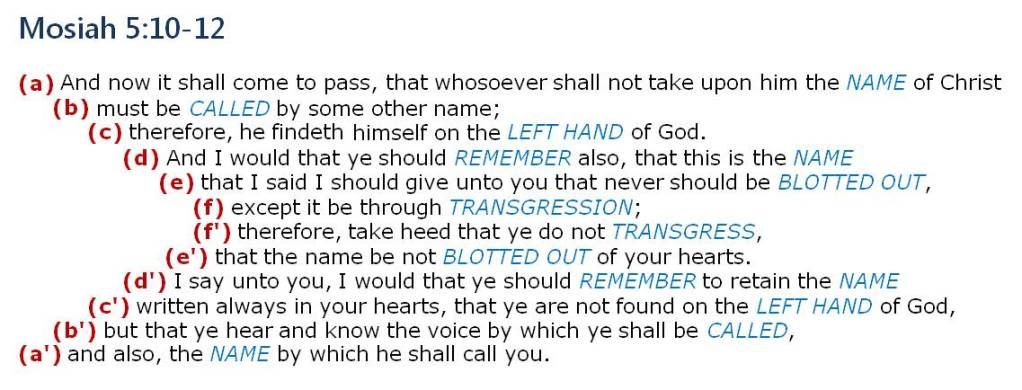Chiasmus in the Book of Mormon
There’s a very cool story in a video posted recently on youtube. Greg Welch tells the story of his father John Welch discovering chiasmus in the Book of Mormon. It’s a touching video. Greg’s love for his father is evident, and John’s truth seeking character is exemplary. As a BYU grad, BYU sports fan, and currently a BYU dad, I’m a big BYU supporter. I loved seeing how the seeds of John Welch’s intellectualism and inquisitiveness were planted before his mission in his freshman BYU classes.
I love these stories that show the creativity and investigative skills of researchers who discover something new. It reminds me of a couple of Don Bradley’s discoveries lately: his presentation on the Kinderhook Plates and also the discovery of a document signed by Eliza Snow showing Fannie Alger as a plural wife of Joseph Smith and not an affair, which critics have accused.
Chiasmus is a literary technique where something is written, then it’s repeated but in reverse. So the pattern goes A-B, B-A or A-B-C, C-B-A. Complicated chiasmus can go very deep before being repeated in reverse. Chiasmus are found in the Bible, and are considered a style element of ancient Hebrew writing.
I loved the video, but I disagree with Greg’s closing statement ‘Chiasmus in the Book of Mormon is evidence that it is an ancient work and not a 19th century work.’

The loose translation theory is the theory that most LDS apologists favor to explain why there are problems in the Book of Mormon text, such as anachronisms, KJV mistakes, etc. The idea is that Joseph had literary license to kind of ‘wing it’ as he translated. And he plugged in his own language. For example, the Book of Mormon prophet might have meant tapir and Joseph described it as horse. Or he saw passages similar to the Bible, so he went ahead and plugged in sections from the KJV. Loose translation would seem to rule out the possibility of the existence of ancient Hebraisms preserved in the text, at least at this level of complexity.
The Limited Geography Theory is the theory LDS apologists favor to explain why Israelite DNA is not found in Native Americans. The theory goes that the Lehites quickly intermarried with natives and assimilated into a preexisting culture, dumping their culture, language, and technology. Everything that could identify them as Israelites quickly vanished. Chiasmus and Hebraisms in the Book of Mormon go against this theory, and it is why scholars like Brant Gardner, a leading Book of Mormon scholar, actually argue against this. Edit: Brant Gardner actually argues that Mesoamerican literature contains chiasmus.
The other problem is that chiasmus and other Hebraisms might seem foreign to a 21st century audience, but they apparently were more understood in Joseph’s time. Authors would intentionally mimic KJV style Old English in order to make their writings sound ancient or sound like the Bible. Chiasmus and Hebraisms appear in these other writings from Joseph’s time. So the existence of chiasmus and Hebraisms might be evidence the work is ancient, but it also might be evidence of someone trying to fake like it was ancient.
These difficult historical issues for the Book of Mormon may challenge its historicity, but in no way do they challenge the truth and spiritual value millions of LDS find in its message. The way to make sense of this is to expand the perspective of truth and scripture and religion from a literal paradigm to a metaphorical paradigm. I believe this can help members retain their faith in the restored gospel of Jesus Christ, while letting go of unnecessary historical/factual obstacles.
Street
ABBA Father
CASteinman
‘ Chiasmus and Hebraisms appear in these other writings from Joseph’s time. ‘
Chiasmus is used too generally in this statement. Chiasmus may occur in small snippets and in even by chance in short structures where it was never intended. However, it is not artistically complex.
The Chiasmus found in ancient literature is artistically complex. It is of an entirely different quality and nature. And the Chiasmus found in the Book of Mormon is some of the most artistically complex.
This quality should be accounted for.
Helen Mar Kimble
CASteinman, you are correct that they can occur in small snippets, but in Joseph’s time, there were MANY books that contained this style of writing. Some of the most obvious, coming from direct duplications from the KJV, and other not so ‘plagiarized’ instances coming from books like View of the Hebrews or The Late War. Each of these are also linked to possible sources for the BOM. If chiasmus is the best evidence for the authenticity of the BOM as divine scripture, the church is doomed.